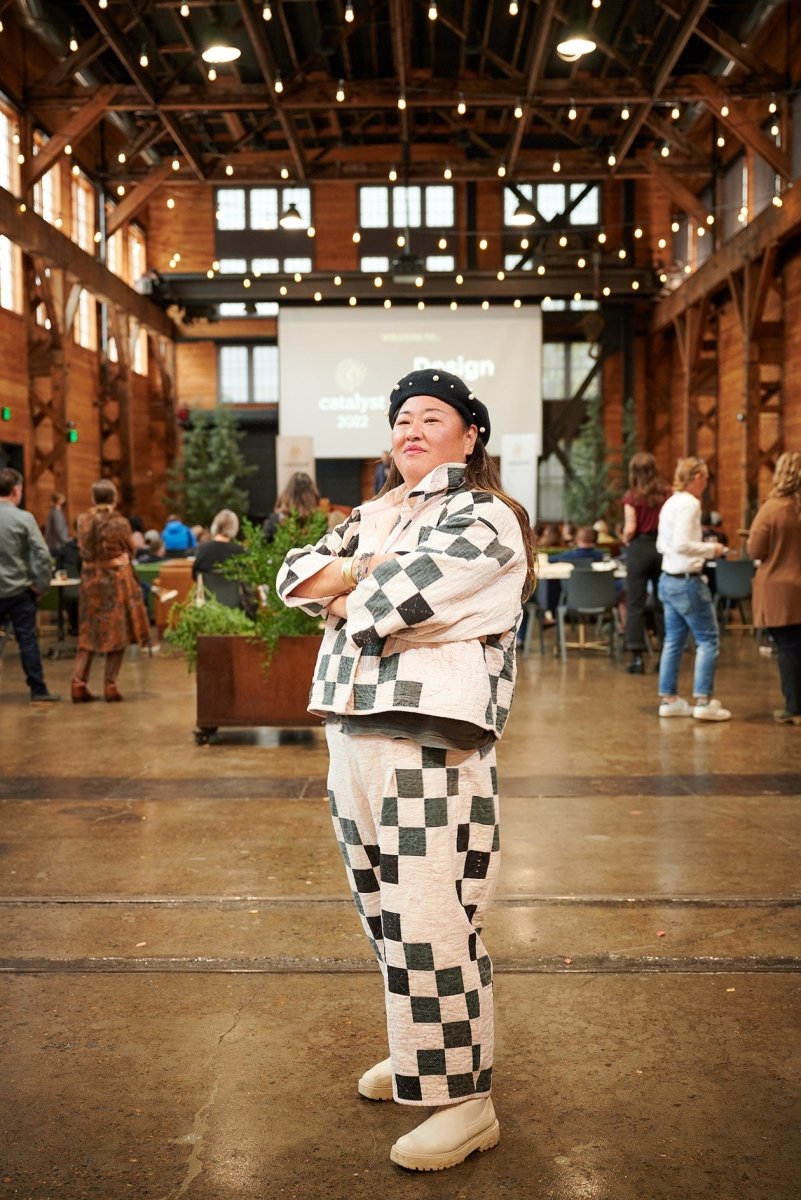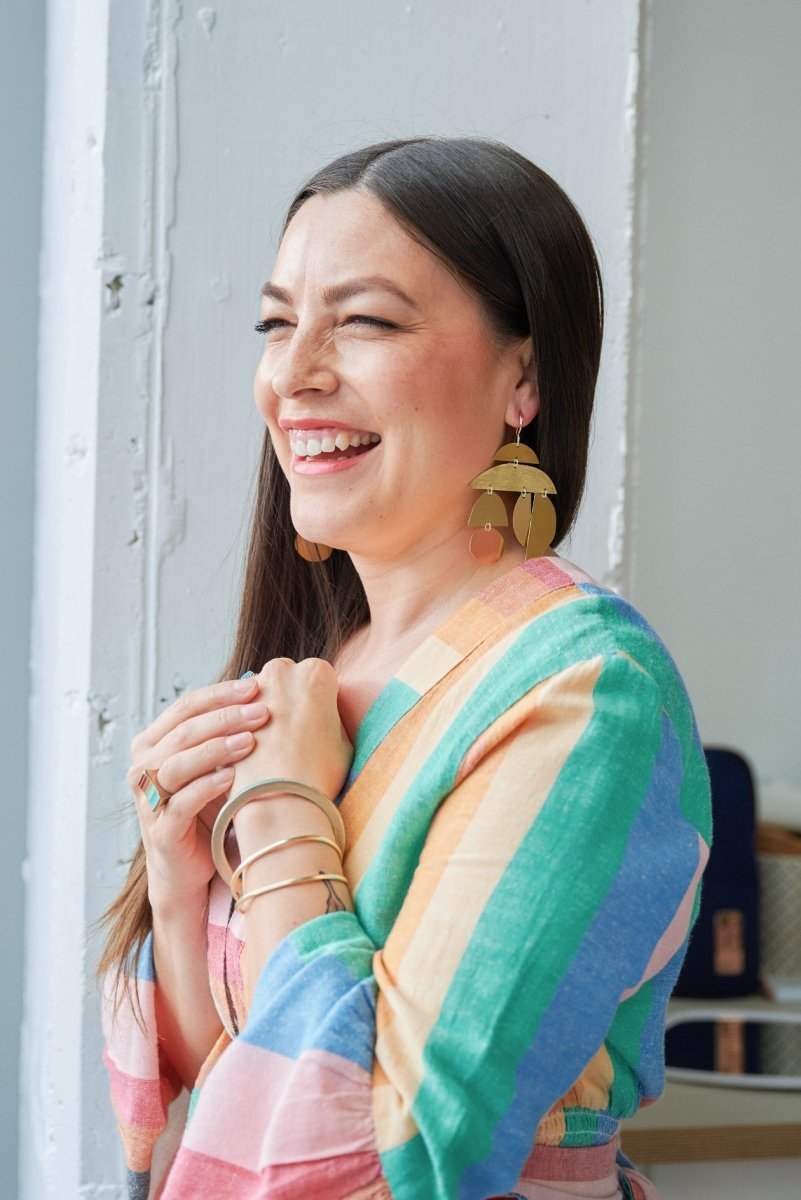By Frayn Masters | 11/9/2022
“So much of my life has been asking myself, “What do I need to solve this?” So, I took action even when I was at home. Early on, like most kids, I wanted to fit in. If I wanted anything extra, anything fun, it was on me, so if I wanted all the latest styles, I needed to work hard, and sew it myself. That’s when I realized, the joy and passion I have, for clothes, and the beauty they bring.”
Upon hearing she bears a striking resemblance to Annie Lennox, stylist Judith Rizzio’s eyes get big, she throws her arms up with glee, and says, “Thank you! I love it! We’re both 68!!” Sitting across from me in her 1923 Craftsman bungalow’s breakfast nook, Judith blinks an unflinching gaze lit with a groovy humanistic love. Wearing a darling shift dress she made, she says, “I am always making pattern changes and finding vintage fabric at thrift stores and yard sales.”
Even as a very young girl growing up in New Jersey, Judith was sensate, very visual, and mesmerized by, notably, 1940s actress Loretta Young, magazines, and her parents' sense of style. Examining how things were put together was instructive and joyous, and she paid close attention to construction and the ways her icons put accessories and pieces together. Judith lights up when creating a meticulous snapshot of her mother’s Christmas outfit, “A gorgeous burgundy rose velvet fitted dress, a classic ‘50s waist, three quarter sleeve. My mother is a very beautiful woman and to me it was magic.” Her father had matching holiday outfits tailored for her and her older sister. Judith calls up every detail down to the perfect piping. While her mother had a sense of fun around her outfits, her father’s take on style came with restrictive rules around eating that was devastating to Judith, affecting her love of self and body.

A peek into Judith's eclectic closet. Shop her look here.
Judith was a bit of a clown, before photos, her father would say, “Judy baby, don’t make that face.” But this part of her could not be snuffed out and Judith eventually embraced her body and that animated clown’s vulnerable-curious-what-rules? face, allowing the very special essence of her oeuvre to step into the ring. With artistry as her stalwart co-pilot, Judith has leaned into creating clothing as a canvas to help navigate the twists and turns of her life.
When Judith was a tween, she took solace in sewing. Manipulating fabric made her feel good, creating the latest looks helped her to fit in. She’d saved up her babysitting money to buy Seventeen Magazine, patterns, notions, and fabric. With an ambitious work ethic that she credits to her father, she’d work late into the night while sitting at Grandmother’s sewing machine recreating what she’d circled on the magazine pages. Her mother championed her little night owl’s drive, listening in marvel to the rapid fire humming stitching young Judith’s visions into reality. Taking control of her needs with her burgeoning skills helped Judith survive a tumultuous situation.
At 13, in the 60’s, she traveled from Jersey to Philly with an older ‘racy’ friend to go to a local American Bandstand-esque TV show. To get on, she lied about her age–you had to be 15. Still beaming about the night – it’s wonderfully apparent how much this moment meant to her at the time — she describes the triumphant styling of her outfit that she worked very hard on: a ribbed polyester “poorboy top,” two-tone neon fishnets, white vinyl mary janes, and a white vinyl mini skirt she made, complete with neon pink and chartreuse little flowers, and giant belt loops with a must have white belt “as big as the skirt.” Emphasizing that she was equally as comfortable as a tomboy that often wore jeans, suspenders, and a dirty t-shirt, there’s no doubt she’d caught the bug for styling.

“Dressing like a hippie was a political statement. It immediately said who you were: ‘I am not a part of the establishment.’ My father hated it.”
In the early 70's, as a high school junior, Judith got into a “very put together hippie” motif of the fired up activist she was becoming. She saw the play Hair 13 times after it made an indelible mark on her. She says, “Dressing like a hippie was a political statement. It immediately said who you were: ‘I am not a part of the establishment.’ My father hated it.” Granny dresses and jeans that were covered with patches were all the rage, and Judith was skilled at both and making money selling them. She was so good at it, in fact, that one summer while in Chappaquiddick, John F. Kennedy Jr. saw her handiwork and commissioned a pair of patched jeans.
Judith started skipping school and traveling to the Bowery in New York around this time, hitting up the original Kiehl’s (for “outrageous patchouli oil”) and the Salvation Army next door. She’d read in Rolling Stone that these were the rumored stomping grounds for movie stars and hero musicians. Though she didn’t have the dough to buy stuff at Kiehl’s, she did get mad deals at the Salvation Army, just like Patti Smith did. Judith was a sustainability siren, hacking queen, and vintage aficionado long before those habits became de rigueur. Once she scored a Civil War uniform, deconstructing it and repurposing the buttons. Judith reflected on how at the time, the Civil War was not that far back, relatively speaking, and people give items from their grandparents to the Salvation Army. “It was that close in time,” she says. The thought penetrates the moment, noting the meaning of a uniform, of clothing, and how they mark time emotionally and historically.

Judith lounges in her delightfully decorated 1923 bungalow. Shop Judith's look here.
Feeling the need to be out of her home, Judith traveled around with groups of friends, making clothes and getting by. This eventually caused her to miss her high school graduation. Even though she only attended 63 days of her senior year, she graduated with honors, winning several art awards. Still, she did not attend the actual ceremony; a lost moment she cried about all night.
Judith went on to Evergreen State College in Olympia, Washington. She enrolled with a focus on theater arts and a minor in geriatric management. She loved it, but her money would run out, so she’d hitchhike to the Salvation Army to get clothes to reconstruct and sell, and make food for people to make money. Her work with clothing turned into her making costumes for the campus political theater group; the perfect combination for her activism and clothing construction skills.
“Early on, like most kids, I wanted to fit in. If I wanted anything extra, anything fun, it was on me, so if I wanted all the latest styles, I needed to work hard, and sew it myself. That’s when I realized, the joy and passion I have, for clothes, and the beauty they bring.”

This pattern continued. In San Francisco, during the summer of ‘76, she studied with the political theater at the Cultural Arts Center. It was a combination of all the radical theater companies from Mexico, the UK, Canada and all over the US. “We were all together and it was unbelievably cool,” she says. Judith had known, though she knew no name for it, that she was queer from a very young age. The gay rights movement was just beginning to flourish with a group called the United Fruit Company. Unfortunately, during this time was also when HIV and AIDS were coming to the fore. Judith became very active in supporting her friends, and helping to give voice to the cause. She recently put together an exhibit of photos and stories from that time at the Oregon Historical Society.
Starting in 1980, Judith ran thrift stores for The American Cancer Society and YWCA for 10 years, where she saw 10s of 1000s of clothing pieces pass by. Every piece logged into her style hippocampus. At the stores, she began styling people. Because of her past, she could key into people who were looking, but nervous to try things, and gently nudge them to see themselves as they wished to. It still wasn’t as accepted at this time to be a drag queen or trans woman. Whenever Judith noticed a trans woman or queen shopping, she’d quietly walk up to them and encourage them to come back after hours. And they did. In those more private moments they could let their soul loose and have some damn fine fun shopping.

Judith pairs bold, vintage patterns with geometric B&I pieces. Shop her look here.
Pairing her history with a Wikipedia-like knowledge of her craft, Judith connects to her clientele, through her business Out of Our Closet, from this deeply woven wealth of experience triumphs, flaws, alterations, activism, and all. With over 40 years experience styling, making and collecting clothing, her website says it best, “as the style activist, I use my experience to help people push against the privilege of fashion to make it accessible and fun for everyone.” Her styling survey and philosophy shakes a mirror like an Etch-a-Sketch, clearing the slate and turning knobs that reveal any number of ways for clients to see themselves. Judith swings the closet door wide open for all woman-identifying individuals, of all incomes, especially those over 40, to be as seen as hot–whatever that means to them personally—and, as fancified as whatever they want to be or try on. Beauty standards be damned, it is who it is inside her clients that aches to be revealed.

“As the style activist, I use my experience to help people push against the privilege of fashion to make it accessible and fun for everyone.”
Can changing clothes really change the vantage point of a client? Sure, if even for a moment. But, Judith is clear she is not a therapist. Once a new look is put on, it may feel as intense as a snake slithering across a foot. Momentarily offering a Wow, I am not sure about this, what is that? Is that me? NOOO. And the look can be discarded just as quickly. But, her clients are left with a feeling of exhilaration. An emotion has been brought to the surface, and feeling something different can be the beginning of seeing something different in themselves. Her work is clearly striking a nerve with national coverage in both VICE and on Good Morning America.
There are few things more revealing than getting dressed and getting undressed. How comfortable are you in the unadorned form, and how do you wish to adorn yourself? No matter what choice you make you say a little something about yourself. From designer, to vintage, to whatever you slide on, it is your style, whether in front of yourself and a mirror or in front of someone else. What our style reveals is the way we wish to represent ourselves in the world. As a passenger in the style spaceship, what you want is an empath as captain. Judith Rizzio is that captain.

PRODUCED BY FRAYN MASTERS
PHOTOS BY AARON LEE
You can check out Judith's website right here. Her services include personal shopping, closet clean-outs, style advice and more. She works in-person, on Zoom, at a sliding scale and sometimes trade.



